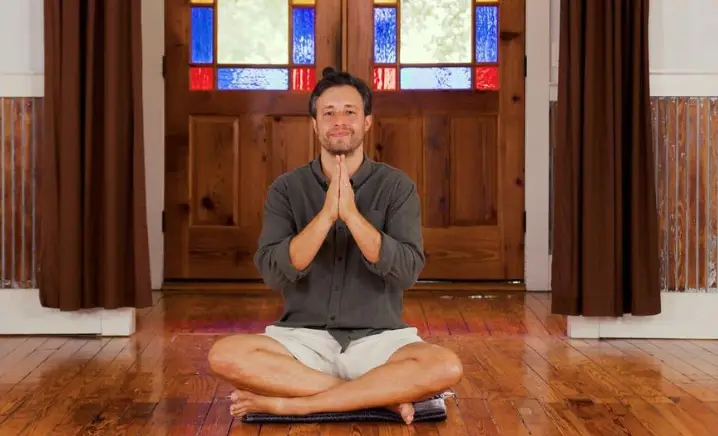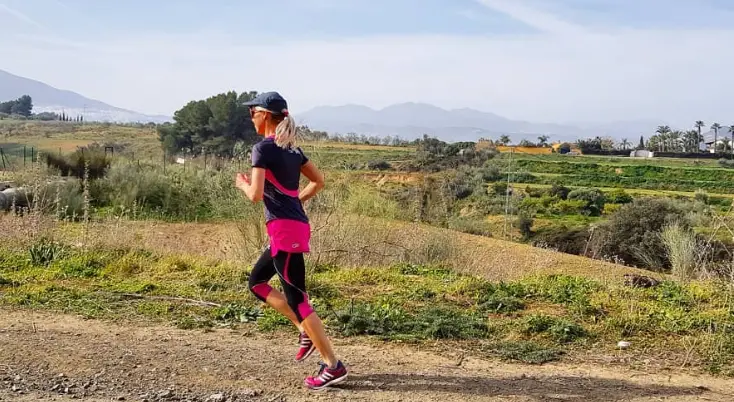OSHO dynamic meditation or more commonly known as active meditation is a form of meditation that revolves around the concept of meditating and working at the same time.
This meditative state allows the practitioner to meditate in the present moment without defocusing on the task at hand. Due to this convenience, active meditation is the perfect choice for people who have a busy schedule or issues with traditional meditation.
While it sounds all easy, if you don’t understand the basics and concepts behind active meditation then you won’t be able to fully experience it. And instead of doing you good, it will only create more stress & issues for yourself.
That’s why in this article, we will provide you with an in-depth guide on active meditation, who it is for, the benefits, and how to practice it properly. So, let’s dive into the details, shall we?

What is Active Meditation?

Active meditation is a form of motion meditation. In this type of motion meditation, the practitioners focus on doing physical chores or activities while searching for zen. It is the meditative state that we reach while conducting any form of physical activity.
But the focus here is not to concentrate on the activity but instead to search for calmness of mind and understand the surroundings. In active meditation, our mind wanders from one point to another while our body moves to complete the task that we have started.
The purpose behind active meditation is to allow people a meditation option that doesn’t require them to sit still for an extended period of time or focus on any type of physical exercise. Due to this, incorporating active meditation into our day-to-day life is quite easy.
But there is a catch. Practicing meditation without paying attention to the task at hand can be a bit tricky and certain techniques along with tips must be followed in order to reap the benefits of this meditation type. Regular practice and focusing on the fundamentals of meditation is the key to success when it comes to active meditation.
Benefits of Active Meditation

So, now that we have a general idea of what active meditation is, let’s take a look at the benefits one may enjoy once one starts to utilize active meditation in their lifestyle.
No More Long Periods of Meditation
Many of us have extremely busy schedules which don’t allow us to separate a good amount of time just for meditation. There are also people with ADHD or other physical conditions who just can’t sit still for an extended period of time.
So most of the time, practicing meditation becomes a chore and bothersome topic for people like this. But that is not the case for active meditation. Active meditation is the light version of traditional meditation that doesn’t require the users to spend a dedicated period of time for this practice. That is why it can be followed easily by anyone.
Stress Reduction
Reduction of stress is the most common and one of the most crucial benefits of meditation and it is the same for active meditation as well. By doing motion meditation, one will be able to significantly reduce the amount of stress one feels while doing daily tasks. This is applicable to both mental and physical stress.
Studies have shown that meditating through physical activity can negate the effects of stress hormones like cortisol along with adrenaline. This happens due to the release of endorphins (which makes us feel happy). Also as our muscles get stimulated while our mind is at ease, there are no forced movements, therefore our muscles can relax as well.
Active meditation conducted through physical activities like tai chi, yoga, or martial arts has confirmed this claim with wonderful results. As our stress levels become low, so does our blood pressure level, which is why many doctors recommend active meditation for patients with high blood pressure. This is also true for improving heart health too.
Increases Focus
Now, this may seem a little contradictory to most people, but when we start to practice active meditation our focus increases gradually. You may think that as the mind wanders while we work it decreases our focus. But no, that is not the case.
This is because the key purpose of active meditation is to feel the surroundings while our body moves. We are not letting our rational minds go rather we are feeling everything on a deeper level than we are used to. This allows our mind to observe the intricate patterns of any activity and instinctively raises our focus and awareness.
Practicing mindfulness this way makes us more attentive and allows us to solve complicated problems with ease. Doing this also significantly increases our mental health and leads us to a better and healthy lifestyle.
How to Practice Active Meditation?
There is no ideal way of active meditation, everyone finds their own way to reach zen. that being said, there are certain practices that will allow you to focus on yourself easily. These are the core part of any meditation so paying attention to them will be beneficial nonetheless.
Step 1: Start with Deep Breathing Techniques
Controlling one’s breathing and mastering different techniques are always recommended if you want to explore the world of meditation and mindfulness. To learn different breathing techniques you will need to practice.
But it is not a requirement to do active meditation. Just take a deep breath before you start to focus on your senses to start your active meditation practice. When you breathe deeply your body starts to relax, that is why every type of meditation requires the practitioner to take deep breaths.
Step 2: Live in the Present Moment
The next step that will allow you to delve into active meditation is living in the moment. Let go of any thoughts of what you will be doing after a few hours or what you have already done in the past. Allow your brain to let go of all thoughts except for the activity you are in right now.
Doing so will allow your head to be free and you will be able to focus on what is happening around you more. This is crucial for meditation because only when you are living in the moment is when you can truly find peace through active meditation.
Step 3: Use Your Senses to Feel the Surroundings
Once your mind has settled in the present moment, now it’s time for you to use your senses and feel what is going on around you. You should be using all five of your senses. So, touch & feel, try to listen, smell what is happening around you, look out for the changes in the environment, and try to taste everything from your mind.
This way you will be able to take in all the energy that surrounds the physical activity you have chosen to do active meditation with. After your senses have come alive, you can proceed to look deeper into your feelings.
Step 4: Try to be Spiritual
Now it is time to focus on your mind. Try to visualize your thoughts, and let your mind start dancing in the hallways of your feelings. What is this activity making you feel? How is this different from others? What makes it enjoyable or regrettable? Try to find the deeper meaning and soon you will reach mindfulness.
Sometimes people play music to make the mind focus more swiftly. It has been proven that melodious sound offers a positive effect on the brain so you can also incorporate music if you are having trouble getting into active meditation.
Step 5: Don’t Worry About Movements or Exercises
A common mistake that many make when they are starting with active meditation is to focus way too much to perfect the daily activity. There is no such need for that. Meditation is supposed to lower your anxiety not increase it. So, don’t worry if you are missing some steps or not doing everything by the book.
All that matter is if you are feeling what you are doing or not. If you can feel your work then you are doing just fine. No need to force yourself. So, just calm your mind and do your regular chores while following the mentioned steps.
Some Common Active Meditation Practices
You might be wondering, active meditation revolves around meditating while doing the physical activity but what sort of physical activity qualifies to be a part of active meditation?
Well, any form of physical activity can be part of active meditation but for regular practice, it is recommended that you pick an activity that you do on a daily basis. With that in mind, here are some common active meditation practices that people follow:
Cooking or Preparing Meals
Meal prep is a crucial part of our day to day life and you can easily start active meditation while you cook.
The trick here is to focus on all of your five senses. So, when you are cooking don’t just chop the vegetables or meat but instead feel the rhythm of the knife coming down on the cooking board. Notice how your hand moves, smell the air around you, and see how the aroma changes as you cook.
Try to notice how the warmth of your body changes as you make the food. Do you feel the warmth? Check up on your emotions as well. What is your mind thinking as you cook a meal for yourself or your friends or for your family members? Diving deep into these thoughts while cooking allows a person to easily align active meditation while they are cooking.
Cleaning Your Surroundings
Reorganizing and cleaning can also be a regular activity that can be incorporated with active meditation. Similar to the previously mentioned steps in cooking. Users should try to utilize all of their senses and dive deep into thought while they are cleaning and reorganizing their surroundings.
They should touch and feel the objects they are holding, the warmth, the comfort of them. How the smell changes, what their eyes see when the dust is removed, how cleaning a certain object makes them feel, and more.
The feeling of washing dishes and cleaning the sofa is completely different and when you can notice the difference in your soul, that is when you will know that you are following the ideal way of active meditation.
Taking a Shower
Showering or taking a bath is arguably one of the most common things we do in our day-to-day lives. As the body normally starts to relax when we are showering or bathing, it is the ideal option to embrace active meditation too.
So, don’t sit still in the showering but try to feel your body as water is pouring down on you. Feel the temperature, what your mind is thinking, and how your senses are reacting. This is one of the easiest ways to start active meditation but is one of the most effective as well.
Walking or Running
As we are walking or running, we can focus and increase our awareness to start meditation. See your surroundings, how the wind is responding to your skin, how your heart is beating. How the leg muscles are reacting to your steps and try to find a deeper meaning.
Exervises & Yoga Positions
Exercises are also a good part of our modern world and you can dive into meditation while working out. This is especially easy when you are doing yoga positions or body stretches that originate from Yoga or Tai Chi.
Controlling your breath and focusing on the mind during your exercise sessions can give you a much deeper insight into yourself than you can imagine. Just be aware of your surroundings, and senses and focus on yourself, only then you will be able to explore mindfulness.
Traditional Passive Meditation or Active Meditation: Which is Better?
So, which type of meditation should you choose? The traditional passive meditation methods that involve clearing your mind by sitting still for long hours or diving deep into your inner thoughts while working on a task? Well, there are a lot of factors to be considered here.
· Passive Meditation requires patience
Passive meditation allows users to clear their minds and learn to focus. By practicing passive meditation most people can easily reach a zen-like state after a few regular practices. The true goal of passive meditation is to gain self-awareness from nothing in particular.
But to reach that self-awareness state, you will need to learn meditation positions and sit still for a long period of time. For example, sitting in the liberation position for half an hour without opening your eyes and diving deep into yourself. You will also have to learn breathing techniques to fully incorporate passive meditation into your lifestyle.
On the other hand, active meditation requires you to focus on a daily task and meditate while you are doing that task. Unlike passive meditation where you are not focusing on anything, here you are focusing on everything with your senses and trying to find deeper mindfulness through them.
· Active meditation requires skills
Also, active meditation doesn’t requires you to remain and sit still for hours nor does it require you to have a specific period of your day to be kept for practicing meditation. You can do active meditation with any physical skill that you have. For example. if you know how to dance then you can actively meditate while dancing.
So, does this mean active meditation is superior to passive meditation? No, it depends on the individuals performing these meditations. Passive meditation is crucial if you truly want to master zen and self-awareness. While active meditation is for those who want to meditate while they work, and don’t have time to spare just for meditation and such.
· You can get the best of both worlds by combining both!
Combining active and passive meditation in your lifestyle ensures the best result out of both. It has also been proven that if you can properly understand and learn how to meditate passively then it becomes extremely easy for a person to perform active meditation.
This is due to the fact that through passive meditation you have already become more self-aware and also learned breathing techniques, yoga poses & focus. So, if you add these skills when you are starting active meditation then you will be able to get a much better result compared to people who don’t have any knowledge regarding passive meditation.
Therefore, instead of putting active and passive meditation against each other, you should try to embrace both of them, if you want to see a better result overall.
Final Thoughts
Active meditation is a great way to introduce the benefits of meditation in our busy lives. As doing it doesn’t require us to sit still or think of anything else but the work in hand, anyone can do it at any time.
But make sure to follow the steps and practice examples we have provided in this guide if you want a better result. Best of luck!
